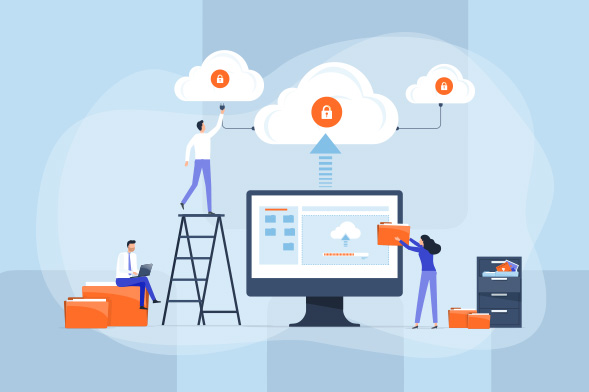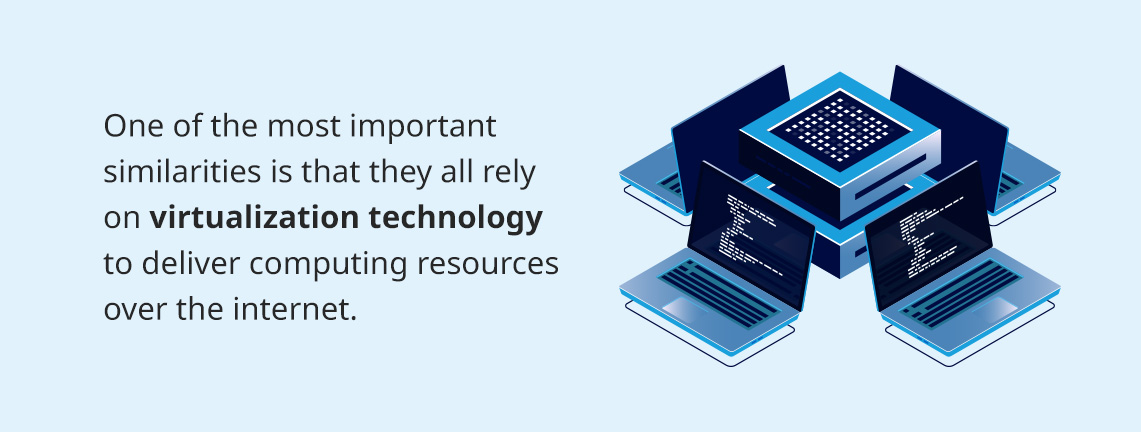
What Are the 4 Types of Cloud Computing?
If you’ve ever heard someone talking about “cloud computing” and wondered what they meant, you’re not alone. This is a ubiquitous term in the tech world, but it can be challenging to understand what it refers to and how it works. Essentially, cloud computing is a way of accessing and storing data and applications over the internet rather than on a local computer or server.
In this blog post, we’ll explore the four types of cloud computing, what sets each of them apart and what similarities they share. By the end, you’ll better understand the different types of cloud computing and which one best suits your organizational needs.
Table of Contents
- The 4 Types of Clouds
- The Similarities of Each Cloud
- The Differences of Each Cloud
- Which Cloud Solution Is Best for Your Organization?
The 4 Types of Clouds
The different types of cloud computing are public, private, hybrid and multi-cloud. Here’s an overview of each one:
1. Public Clouds
Public clouds are owned, operated and provided by third-party providers, which deliver computing resources like servers, storage and applications over the internet. This means users can access these resources on a pay-per-use basis without investing in or maintaining their own hardware or software.
Public clouds are ideal for businesses with varying computing needs, as they can quickly scale up or down based on demand. They’re also cost-effective, as users only pay for the resources they use. However, public clouds are shared by multiple users, which means data security and privacy may be a concern. Additionally, because public clouds are accessed over the internet, their performance can be affected by network traffic and bandwidth limitations.
2. Private Clouds
Private clouds are dedicated computing environments used exclusively by a single organization. They can be hosted either on-premises or by a third-party provider and are typically used by large enterprises or organizations with strict data privacy or regulatory requirements.
Private clouds offer greater data security and privacy control, as multiple users don’t share them. They can also provide better performance and reliability because they’re not subject to network limitations like public clouds.
However, private clouds can be more expensive to operate and maintain than public clouds, as they require dedicated hardware and software.
3. Hybrid Clouds
As the name suggests, hybrid clouds combine elements of both public and private clouds. They allow organizations to use a mix of on-premises infrastructure and public cloud resources to meet their computing needs.
This can provide greater flexibility and cost-effectiveness, as organizations can use public clouds for less sensitive data and applications while keeping more sensitive data and applications on private clouds. Hybrid clouds can also help organizations address concerns around data authority. They can choose to store sensitive data on-premises while still taking advantage of the benefits of public cloud computing.
However, hybrid clouds can be complex to set up and manage, as organizations must ensure their on-premises infrastructure and public cloud resources work together seamlessly.
4. Multi-Clouds
Multi-clouds are multiple public cloud providers used to meet an organization’s computing needs. This can include different cloud providers for various applications or workloads or to avoid vendor lock-in.
Multi-clouds offer greater flexibility and choice, as organizations can choose the cloud provider that best suits their specific needs for each application or workload. They can also provide redundancy and failover options, as organizations can easily switch between cloud providers in case of an outage or other issues.
That said, managing multiple cloud providers can be complex, and organizations must ensure their applications and workloads are compatible with each provider.
The Similarities of Each Cloud
While public, private, hybrid and multi-clouds have unique characteristics and use cases, they also share some key similarities. One of the most important similarities is that they all rely on virtualization technology to deliver computing resources over the internet.

Virtualization allows multiple virtual machines to run on a single physical server, which maximizes resource utilization and allows for greater flexibility and scalability. This technology is used in all types of cloud computing, whether it’s a public cloud hosted by a third-party provider or a private cloud hosted on-premises by an organization.
Another similarity between the four types of clouds is that they all offer some level of automation and self-service. Users can quickly provide and manage computing resources without interacting directly with the underlying infrastructure. This can help reduce the burden on IT staff and improve efficiency and agility.
Finally, all types of clouds rely on secure access controls and encryption to protect sensitive data and applications. Whether it’s a public cloud accessed via the internet or a private cloud hosted on-premises, security is a top priority in all types of cloud computing.
The Differences of Each Cloud
While public, private, hybrid and multi-clouds share some similarities, they also have distinct differences that make them suitable for different workloads and applications.
Public clouds are a cost-effective option with superb scalability. However, they may need to improve the security and customization some businesses need. In contrast, private clouds offer greater security and customization but can be more expensive to operate and maintain.
Hybrid clouds are a mix of public and private clouds, offering the best of both worlds by allowing organizations to balance cost-effectiveness, scalability, security and customization. Multi-clouds involve using multiple public clouds, private clouds or a mix of both to achieve specific organizational needs, such as cost reduction, redundancy or regulatory compliance.
The four types of cloud computing each offer distinct advantages and trade-offs, and the choice of cloud will depend on the specific needs and requirements of the organization.
Which Cloud Solution Is Best for Your Organization?
Choosing the right cloud for your organization can be challenging, but it’s an important decision that can significantly impact your business. To determine which cloud is best for your organization, it’s essential to consider several factors, including cost, security, compliance, performance and scalability.
For organizations with a limited budget and a need for flexibility, a public cloud may be the best choice — as they typically require no upfront investment in hardware or infrastructure. However, organizations should consider the security and compliance implications of using a public cloud, primarily if they handle sensitive data.
In comparison, private clouds offer greater control and security than public clouds, but they also require a significant investment in infrastructure and resources. Private clouds are an excellent choice for organizations requiring strict compliance or security requirements and having the resources to manage and maintain their infrastructure.
Hybrid clouds can be a good fit for organizations that must balance cost, performance and security requirements — allowing organizations to leverage the benefits of public and private clouds.
Finally, multi-clouds offer the ultimate flexibility and choice but also require effective management and oversight. Organizations that choose a multi-cloud approach must carefully consider how they’ll manage and maintain their cloud environments and should be prepared to invest in resources to ensure the security and performance of their systems.

Contact Contigo Technology for Cloud Management
Whether you’re looking for a cost-effective solution that offers flexibility and scalability or a secure and compliant cloud environment that can be customized to your specific needs, there’s a cloud solution that’s right for you.
At Contigo Technology, we understand the complexities of cloud computing and can help you navigate the many options available. With our expert guidance and support, you can rest assured your cloud environment will be optimized for performance, security and compliance.
As a leading provider of IT support throughout Central Texas, we offer a range of services to help businesses stay ahead of the curve, including network audits, quarterly business reviews, phone support and cyber security training.
Contact us today to learn more about how we can help you manage your cloud environment and take your business to the next level.